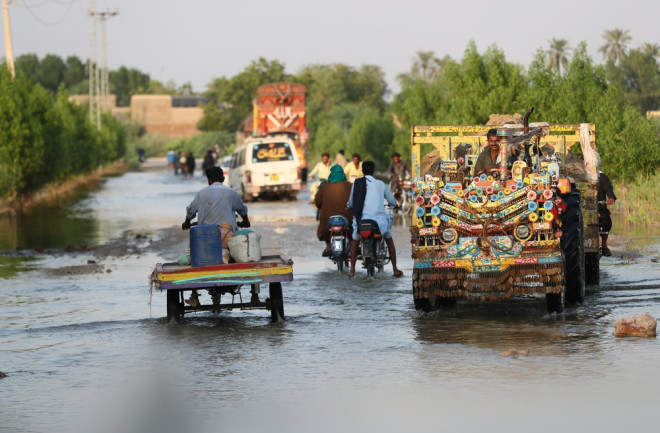In June 2022, Pakistan started to receive an abnormal amount of rain. Within a month, the downpours had submerged substantial swaths of the country.
Wherever the water accumulated, it brought destruction and death. And though the rain stopped several months ago, millions of people are still affected by its wreckage. With this in mind, what were the causes and the consequences of these floods, and what part, if any, did climate change play in the development of the disaster?
What Were the Causes of the Floods?
Pakistan receives almost all of its precipitation in a single season, with around 70 to 75 percent of its annual rain accumulating in June, July, August and September. That said, the amount of precipitation in the country's traditional monsoon months tends to fluctuate from year to year, with some years seeing much more rain than others.
In 2022, Pakistan saw "a monsoon on steroids,” according to U.N. Secretary-General António Guterres, with the country receiving around 250 percent of its average rain in August. And certain parts of the country were hit harder, being battered by anywhere from about 600 to 800 percent of their August averages. At one point in the disaster, patches of Pakistan’s most populous province, Sindh, were barraged by almost 15 inches of rain in a single day.
Over the course of the summer, the waters converged in the low-lying areas around the Indus River. Once collected, the country’s croplands turned into seas, and its villages transformed into islands.
Read More: How To Save Planet Earth
What Were the Consequences of the Floods?
Submerging around 33,000 square miles, or approximately 10 percent of the country’s terrain, the floods damaged and destroyed millions of acres of agricultural fields and millions of residences.
Throughout the summer, 33 million individuals were affected by the floodwaters, with approximately 8 million individuals displaced, 13,000 injured and 2,000 dying as a direct result of the disaster.
In September and October, the rain started to subside. While some swaths of the country began to dry, others remained saturated, without anywhere for the water to drain.
According to the most recent report by the U.N. Office for the Coordination of Humanitarian Affairs, as many as 1.8 million individuals still saw stagnant water within their communities as of March 9, 2023. And whether they saw stagnant water or not, as many as 10 million individuals were still divested of a source of safe drinking water.
Read More: 4 Ways Climate Change Is Already Taking a Toll
Pakistan Under Water
Out of all the possible weather disasters in the world, floods are associated with some of the worst injuries and illnesses. While direct contact with the water can cause drowning and injury, it can also cause infections and irritations in the skin. And the dangers don’t stop there. Because floods can damage water and sanitation systems, people in affected areas can be forced to consume contaminated water, raising their risk of waterborne diarrheal diseases, such as cholera.
Before the start of the floods, Pakistan’s water supply system provided about 92 percent of the population with water, though only around 36 percent of that water was considered to be clean and safe for consumption. Now, with whole sections of these systems sustaining damage from the floods, a smaller amount of that water is thought to be sanitary.
It’s no wonder that Pakistan has seen several outbreaks of diarrheal disease since the monsoon season started. On September 1, 2022, for instance, over 90,000 cases of diarrhea were recorded in Sindh in a single day. And these ongoing outbreaks are only worsened by the fact that around 2,000 hospitals and health facilities have been damaged or destroyed by flooding.
Read More: How Does Climate Change Affect Human Health?
Why Did Pakistan Flood?
In an appeal for support for Pakistan on August 30, 2022, António Guterres said that the floods should serve as a worldwide wake-up call, persuading people to “stop sleepwalking towards the destruction of the planet by climate change.”
The idea that these floods were worsened by climate change is a sensible one. Scientists have long held that extreme precipitation events are intensifying as humans emit greater and greater amounts of greenhouse gases into the atmosphere. As these greenhouse gases accumulate, they heat the air and increase its ability to hold moisture, essentially meaning that when and where it rains, it pours.
Pakistan and Climate Change
Though it tends to be difficult to determine whether climate change contributed to a particular precipitation event, the scientists affiliated with the World Weather Attribution have dedicated themselves to the task. In September, they published a paper that found that climate change increased the intensity of the precipitation in Pakistan by 50 to 75 percent, and thus played a contributing part in the disaster.
Scientists suspect that the intensity of Pakistan’s extreme precipitation events will only worsen with continued climate change. But Pakistan isn’t the only place that will be impacted. “Today, it’s Pakistan,” Guterres said in his appeal in August. “Tomorrow, it could be your country.”
Read More: Climate Change Is Intensifying the Global Water Cycle

